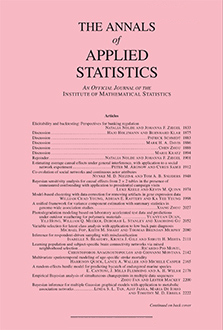Abstract
AIC is commonly used for model selection but the precise value of AIC has no direct interpretation. We are interested in quantifying a difference of risks between two models. This may be useful for both an explanatory point of view or for prediction, where a simpler model may be preferred if it does nearly as well as a more complex model. The difference of risks can be interpreted by linking the risks with relative errors in the computation of probabilities and looking at the values obtained for simple models. A scale of values going from negligible to large is proposed. We propose a normalization of a difference of Akaike criteria for estimating the difference of expected Kullback–Leibler risks between maximum likelihood estimators of the distribution in two different models. The variability of this statistic can be estimated. Thus, an interval can be constructed which contains the true difference of expected Kullback–Leibler risks with a pre-specified probability. A simulation study shows that the method works and it is illustrated on two examples. The first is a study of the relationship between body-mass index and depression in elderly people. The second is the choice between models of HIV dynamics, where one model makes the distinction between activated CD4+ T lymphocytes and the other does not.
Citation
D. Commenges. A. Sayyareh. L. Letenneur. J. Guedj. A. Bar-Hen. "Estimating a difference of Kullback–Leibler risks using a normalized difference of AIC." Ann. Appl. Stat. 2 (3) 1123 - 1142, September 2008. https://doi.org/10.1214/08-AOAS176
Information





